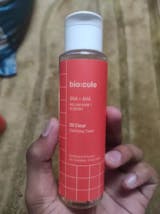BHA + AHA
WILLOW BARK + BILBERRY
Oil Clear Clarifying Toner is an alcohol-free toner containing Natural BHA (Salicylic Acid) & AHA (Lactic Acid) derived from Willow Bark & Bilberry. It is further enriched with Aloe Vera, Neem, Green Tea & Chamomile. It helps to cleanse, minimize & tighten pores, remove excess sebum and provide a gentle peeling effect to promote skin cell regeneration.
- Removes Excess Sebum
- Minimizes Pores
- Gently Exfoliates & Purifies
SUITABLE FOR OILY & NORMAL TO OILY SKIN
Inclusive of all taxes
Couldn't load pickup availability
Ingredients
Ingredients
All the feels
All the feels
Smells Like : Odorless
Feels Like : Non-Sticky Water
Makes Skin Feel : Clean + Plump
Makes Skin Look : Dewy
How to use
How to use
Additional Information
Additional Information






WE ARE IN THIS TOGETHER
Open Pores & Excess Sebum can be your worst enemies...Give Oily & Acne Prone skin the clarity to breathe
we pledge clean beauty
-

Alcohol Free
-

Fragrance Free
-

Mineral Oil Free
-

Paraben Free
-

Silicone Free
-

Sulphate Free
faqs
Is Oil Clear - Clarifying Toner a BHA toner?
How does bilberry benefit the skin?
Can AHAs & BHAs be used together?
Is it necessary to apply sunscreen after using this toner?

















